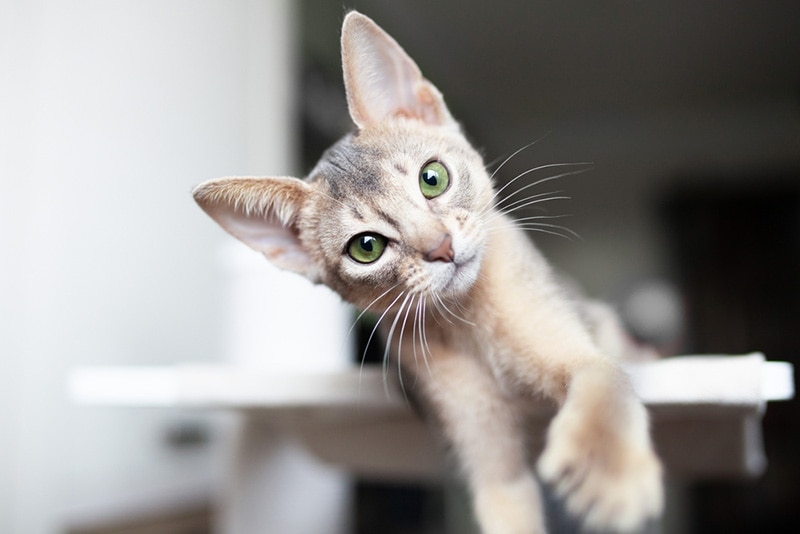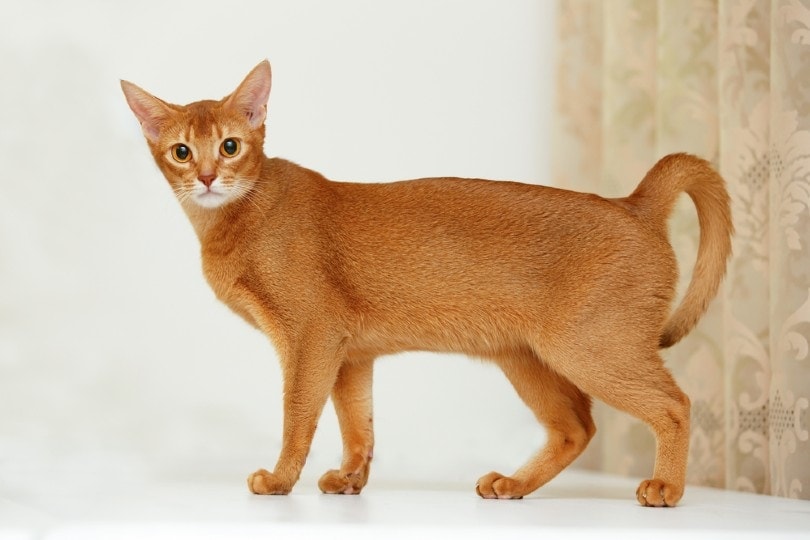Abyssinian Cat Breed Info: Pictures, Care, Traits & Facts

Updated on

| Height: | 8-10 inches |
| Weight: | 12-16 inches |
| Lifespan: | 9-15 years |
| Colors: | Ruddy, cinnamon, blue, fawn |
| Suitable for: | Multi-cat households, families, people looking for an adventurous cat |
| Temperament: | Social, inquisitive, curious, intelligent, adventurous |
The Abyssinian is an elegant cat that is often compared to the cats seen in ancient Egyptian artwork. It’s unclear where they originated from, but they are named for Abyssinia, which is modern day Ethiopia. It is believed this is where the cats originated, but it is debated. It wasn’t until the 1800s that Abyssinians made it to Europe. Some people claim that the original Abyssinian to make it to Europe was a female kitten named “Zula” who was brought to Europe by a British soldier.
Regardless of their origin, the Abyssinian is a popular breed of cat for its desirable personality and curious, social nature. They can be leash trained and often enjoy exploring the outdoors. They are adept climbers, enjoying access to cat trees, real trees, shelves, bookcases, cat wall furniture, and other high up places. If you’re looking for an affectionate cat that will happily go exploring with you, the Abyssinian may be right for you.
 Abyssinian Kittens
Abyssinian Kittens

If you’re looking to purchase an Abyssinian kitten, they can be exceptionally expensive. On rare occasions, you may come across an Abyssinian kitten in an animal shelter.
Abyssinian cats are loved because of their elegant body and intelligence. They are very independent and curious, and if you enjoy cuddles, they have been known to show a decent amount of affection towards their favorite humans.
3 Little-Known Facts About the Abyssinian Cat
1. You may not realize their orange-brown fur color has a specific name.
Abyssinians are easily identifiable by their orange-brown coat with black tick marks. The tip of the tail should be black, and the belly should closely match the rest of the body. This burnt-sienna coat is called “ruddy,” and it is the most common coat color in this breed. Cinnamon, blue, and fawn are the only other colors accepted by the Cat Fancier’s Association, but they are far less common than ruddy coats.
2. They’re very quiet.
This breed is known for its quiet nature. You will rarely, if ever, hear an Abyssinian cat meow or “talk” to you. Although they’re very quiet kitties, it doesn’t mean they’re timid. They’re highly social, active, and always ready for a game or adventure. Their quiet nature may go out the window if you have an intact female in season or an intact male who is looking for a mate. Intact cats of both sexes are known to yowl loudly, even in quieter breeds.
3. They might be more popular than you think.
The Abyssinian is not just one of the most popular cat breeds in the United States, it’s a wildly popular breed. Abyssinians consistently rank in the top 10 most popular cat breeds in the country, often trailing behind more well-known breeds, like the Persian, Maine Coon, Scottish Fold, Ragdoll, and more recently, the Sphynx.

Temperament & Intelligence of the Abyssinian Cat
Are These Cats Good for Families? 👪
This is a fantastic cat breed for families due to their tendency to be social and playful. They are not known for aggression, although rough play can lead to injuries and should be avoided, especially with small children. Children should be taught proper handling and boundaries around any cat to prevent behavioral problems and injuries to the cat. These cats are so social that they are often leash trained and taken on excursions like dogs.
Does This Breed Get Along With Other Pets?
Once again, their social nature is a bonus with the Abyssinian. They are a great addition to multi-cat homes and will typically get along with other cats. They also usually don’t seem to mind dogs and may even play with them. Proper, safe introductions should be done between the cat and dog to ensure everyone will be comfortable and no injuries occur.
When it comes to small animals, proceed with caution. Although not typically aggressive, Abyssinians are still cats and have hunting instincts. It’s not unheard of for them to injure or kill a small pet within the home if left unattended together. Overzealous play can also lead to injuries with smaller animals, even if that wasn’t the intent. It’s best to keep cats away from small animals within the home.

 Things to Know When Owning an Abyssinian Cat:
Things to Know When Owning an Abyssinian Cat:
Food & Diet Requirements 
Due to their increased risk of developing cardiomyopathy, choosing the right diet is essential. Diets lacking in taurine and other nutrients can increase the risk of heart problems developing. Talk to your veterinarian about an appropriate food for your Abyssinian to ensure its heart stays healthy. These cats are usually active enough to burn through the food they eat, so free feeding is often acceptable for them. In fact, many cats seem to prefer free feeding instead of being fed larger meals once or twice daily. Your vet will be able to guide you on the amount of food your cat needs in a day, and then adjustments can be made from there as needed.
- Related Read: Best Cat Food Bowls: Reviews & Top Picks
Exercise 🐈
This breed is definitely not a lap cat! Your Abyssinian will need plenty of exercise and play every day to prevent boredom and behavioral problems. Lots of areas where the cat can be up off the ground will be preferred by your cat. Teaser toys, jingle balls, faux mice, and scratchers are all great items to keep on hand to keep your cat busy and entertained. Supervised outdoor time, leash training, and catios can all add opportunities for your cat to get to experience the outdoors in a way that is safe for your cat and wildlife. Outdoor activities will not only exercise your cat’s body but also stimulate their brain.

Training 🧶
Often topping lists of most trainable cats, the Abyssinian is smart and curious enough to participate in training exercises. Positive reinforcement training techniques can be used to teach your Abyssinian how to walk on a leash, how to perform tricks, and other things that are often associated with dog training. These cats can be trained to perform agility courses and mazes, hoop jumping, and puzzle solving.
Grooming ✂️
The short coat of the Abyssinian means they have minimal grooming needs. Weekly or less frequent brushing is usually adequate for this breed. If the cat has problems with its skin or coat, the veterinarian may recommend bathing with certain shampoos regularly, but otherwise, these cats should not require baths. Nail trims can be performed if your cat’s nails are becoming too long, thickened, or caught in things.

Health and Conditions 🏥
Below you will find common and rare medical conditions that may affect Abyssian cats.
- Dental disease
- Urinary tract infections
- Psychogenic alopecia/overgrooming
- Skin and coat disorders
- Hyperesthesia
- Pyruvate kinase deficiency
- Hip dysplasia
- Patellar luxation
- Inflammatory bowel disease
- Progressive retinal atrophy
- Hyperthyroidism
- Cardiomyopathy
- Feline aortic thromboembolisms
- Kidney disease
- Amyloidosis
- Feline infectious peritonitis
 Male vs. Female
Male vs. Female
Male Abyssinians are typically larger than females, having a larger frame and weighing more. Females tend to have a more lithe figure and are often considered to be more graceful and dignified. Temperament will vary some from cat to cat, but overall, there are few temperament differences between males and females of this breed. This is due to their affectionate personalities and desire to spend time doing activities with their family. Males may be slightly cuddlier and more personable than females, but this is far from always being the case.
 Conclusion
Conclusion
Abyssinians are beautiful cats with a distinct appearance and personality. Their intelligence and desire for social interaction makes them great for active homes, families, and multi-cat homes. They generally get along with other animals, and they are one of the most trainable cat breeds. Their life expectancy is slightly lower than many other cat breeds, but this doesn’t mean they’re not a commitment. Abyssinians typically live to be at least 9 years old, and routinely exceed 15 years. They’re a daily time commitment because of their exercise and play requirements, and they are not a good fit for homes where they may be left for multiple hours every day.
See also:
Featured Image Credit: Irina Grib, Shutterstock
 Abyssinian Kittens
Abyssinian Kittens
 Male vs. Female
Male vs. Female








